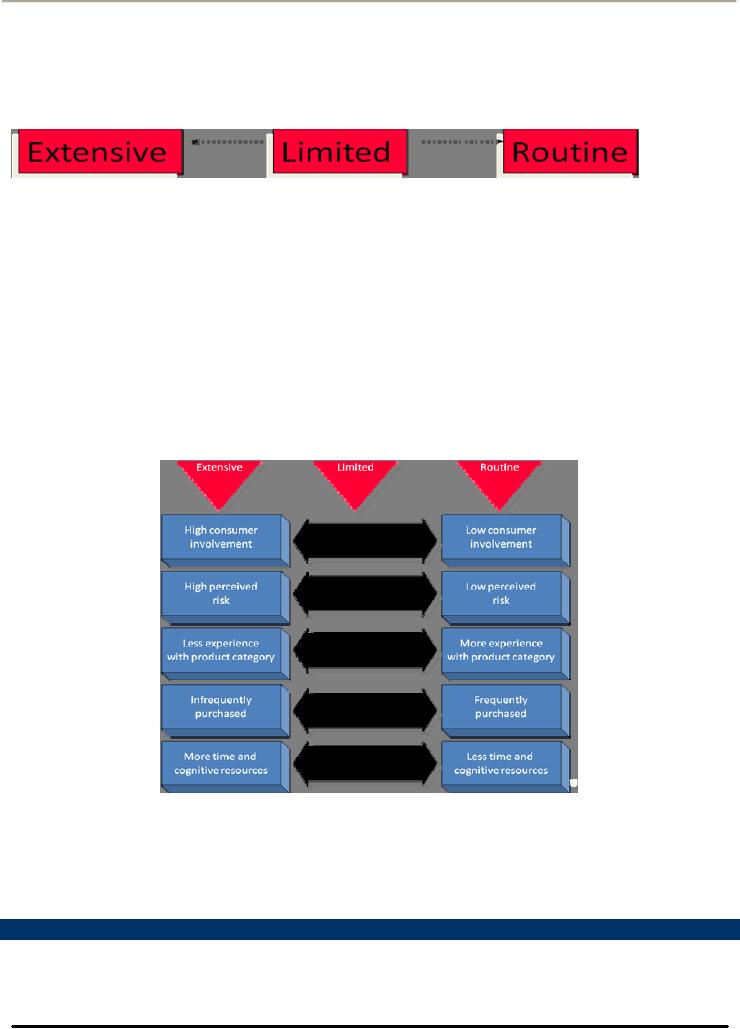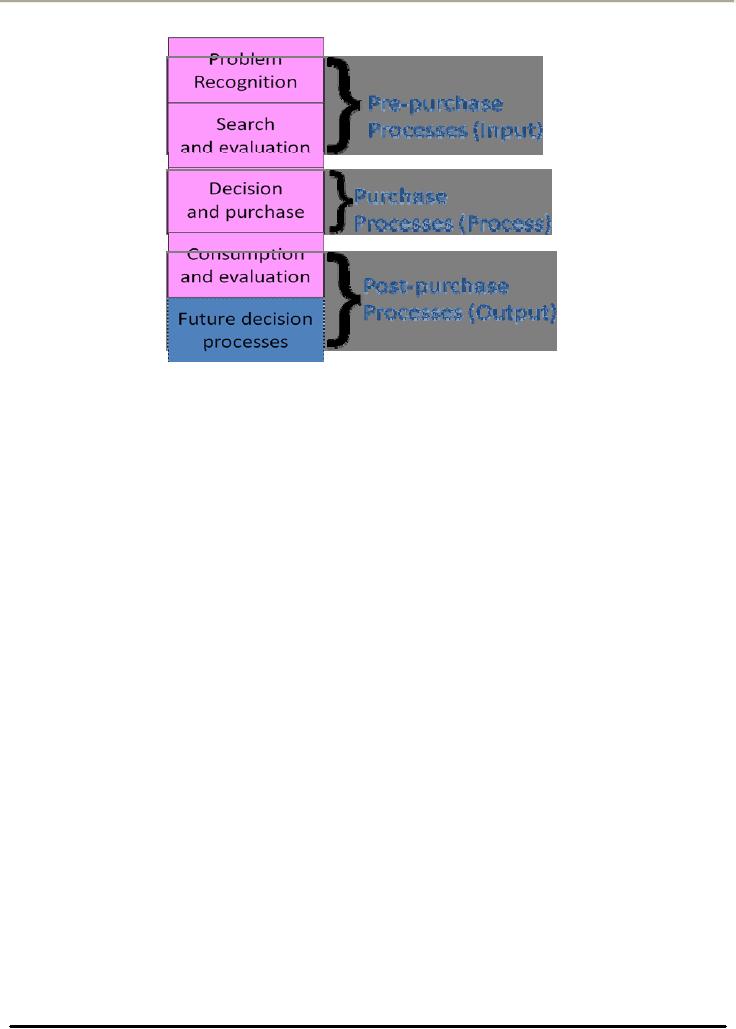 |
INTRODUCTION TO CONSUMER DECISION MAKING:Decision Complexity |
| << ATTITUDE CHANGE STRATEGIES:Resolving two conflicting attitudes |
| Problem Recognition, Search and Evaluation and Decision and Purchase >> |

Consumer
Psychology (PSY -
514)
VU
LESSON36
INTRODUCTION
TO CONSUMER DECISION
MAKING
CHAPTER
6: CONSUMER DECISION
MAKING
Contents
of Chapter No. 6
Input
Marketing
Input
Socio-cultural
Inputs
Process
Need
Recognition
Pre-purchase
search
Evaluation
of Alternatives
Output
Purchase
Behavior
Post-Purchase
Evaluation
Introduction
to Consumer Decision
Making
Usually
the decisions consumers are
face are somewhat like the
ones mentioned below:
What
to buy?
How
much to buy?
Where
to buy?
When
to buy?
How
to buy?
Deciding
what to buy is the most basic
tasks. No buying activity
may take place unless this
fundamental decision is
made.
Here consumers' product or
service decision may
encompass
Generic
category of products (Electronic
Equipment)
Specific
category of products (Computer)
Brands
Prices and Product
features
Specific
Decision
Consumer
must decide, e.g. how
much rice to purchase, how
much oil, how many
cans of cold drinks?
etc...
Two
products although physically
same are likely to be
perceived differently because of
other facets
associated.
Not
all sales outlets are same,
they may differ:
Downtown
or suburban stores
Discount
or full service
stores
Merchandise
lines (full VS. Narrow
Purchase a camera from a brand
shops or a super
store)
Consumers
decide not only on the
general type of store but
also determine a particular
store
The
decision is influenced by such factors
as:
Urgency
of need (medicine)
Availability
of the chosen item (cars)
Store
opening times (appliances before
evening, clothes till late
night)
Period
of sales and
clearances
Availability
of transportation (Public transport or personal
vehicle)
Freedom
of all family members to
shop
Other
concerns are to shop
extensively or shop from the
first outlet, pay cash or
charge, have it delivered or take
it
home.
117

Consumer
Psychology (PSY -
514)
VU
Consumer
decisions vary considerably in their
complexity. Simple decisions
may be about purchasing
food. Buying
durable
goods may be a complicated
decision. Buying a home is
too complicated.
Decision
Complexity
The
nature of decision complexity
may be understood with the help of
following continuum of
situations:
Routine
Problem Solving (RPS)
When
consumers purchase a brand they have
purchased before It involves little or no
information seeking.
Consumers
are brand loyal and purchase
in a habitual, automatic and
unthinking
Limited
Problem Solving (LPS)
When
consumers buy a new brand in a
familiar product category
(e.g. new brand of jeans) It
involves a moderate
amount
of information seeking and time in
choosing.
Extensive
Problem Solving (LPS)
When
consumers buy in an unfamiliar
product category. It involves the
need to obtain substantial
information and
a
longer time to think. Consumers must
form a concept of product
category and determine the criteria to be
used
in
choosing a brand.
The
Dynamics of Problem Solving
Continuum
Consumer
Decision Making
Process
Consumer
Decision making process may be understood in
terms of the following three
stages:
118

Consumer
Psychology (PSY -
514)
VU
119
Table of Contents:
- INTRODUCTION TO CONSUMER PSYCHOLOGY:Consumer Behavior
- INTRODUCTION TO CONSUMER PSYCHOLOGY:Consumer research
- INTRODUCTION TO CONSUMER PSYCHOLOGY:Marketing Mix, Product, Price
- INTRODUCTION TO CONSUMER PSYCHOLOGY:Customer Value, Perceived Value
- VALUE AND RETENTION FOCUSED MARKETING AND CONSUMER DECISION MAKING PROCESS
- CONSUMER RESEARCH:Quantitative Research, Qualitative Research
- MAJOR STEPS IN CONSUMER RESEARCH PROCESS:Design of Primary research
- QUANTITATIVE RESEARCH DESIGNS & DATA COLLECTION METHODS
- QUANTITATIVE RESEARCH DATA COLLECTION TECHNIQUES:ATTITUDE SCALES
- QUALITATIVE RESEARCH DESIGNS & DATA COLLECTION METHODS
- CUSTOMER SATISFACTION MEASUREMENT, SAMPLING, AND DATA ANALYSIS AND REPORTING
- MARKET SEGMENTATION AND ITS BASES:Geographical Segmentation
- BASES FOR SEGMENTATION: DEMOGRAPHIC SEGMENTATION PSYCHOGRAPHIC SEGMENTATION
- BASES FOR SEGMENTATION: SOCIOCULTURAL SEGMENTATION USE RELATED SEGMENTATION USAGE SITUATION SEGMENTATION
- BASES FOR SEGMENTATION: BENEFIT SEGMENTATION:Intrinsic Cues
- BASES FOR SEGMENTATION: HYBRID SEGMENTATION STRATEGIES
- MARKET SEGMENTATION IMPLEMENTING SEGMENTATION STRATEGIES ENVIRONMENTAL INFLUENCES CULTURE
- HOW CULTURE IS LEARNT ENVIRONMENTAL INFLUENCES:Formal Learning
- CULTURE AND ITS MEASUREMENT ENVIRONMENTAL INFLUENCES
- MEASUREMENT OF CULTURE ENVIRONMENTAL INFLUENCES:Consumer Fieldwork
- SUBCULTURE CHAPTER 4: ENVIRONMENTAL INFLUENCES
- AGE AND GENDER SUBCULTURE CHAPTER 4: ENVIRONMENTAL INFLUENCES
- BASES FOR SEGMENTATION: BENEFIT SEGMENTATION:Market Segmentation
- SOCIAL CLASS CHAPTER 4: ENVIRONMENTAL INFLUENCES:Occupation
- CONSUMER SOCIAL CLASSES CHAPTER 4: ENVIRONMENTAL INFLUENCES:Affluent Consumer
- CONSUMER SOCIAL CLASSES CHAPTER 4: ENVIRONMENTAL INFLUENCES:Membership Group
- CONSUMER SOCIAL CLASSES CHAPTER 4: ENVIRONMENTAL INFLUENCES:Shopping Groups
- UNDERSTANDING PERSONALITY CHAPTER 5: INDIVIDUAL DETERMINANTS OF CONSUMER BEHAVIOR
- CONSUMER PERSONALITY, TRAIT THEORY AND SELF IMAGES
- CONSUMER MOTIVATION:Needs, Goals, Generic Goals
- UNDERSTANDING LEARNING:Intentional and Incidental Learning, Implications for Marketers
- INSTRUMENTAL CONDITIONING, INFORMATION PROCESSING AND MEMORY
- ATTITUDES:Characteristics of Attitudes, Attitudes have consistency
- ATTITUDE FORMATION AND CHANGE:How attitudes are learned?
- ATTITUDE CHANGE STRATEGIES:Resolving two conflicting attitudes
- INTRODUCTION TO CONSUMER DECISION MAKING:Decision Complexity
- Problem Recognition, Search and Evaluation and Decision and Purchase
- Decision and Purchase:Consumer Decision Rules, Output, Relationship Marketing
- Decisions Related to Post Purchase:Product Set up and Use
- Marketing Implications of Decisions Related to Post Purchase:Understanding
- Post Purchase Evaluation:Determinants of Satisfaction, Consumer Complaint Behavior
- Post Purchase Dissonance:Dissonance Reduction, Marketing Implications
- Consumerism:Roots of Consumerism, The Nature of Consumerism
- Consumerism – Issues and Responses:Environmental Concerns, Consumer Privacy
- Review – Consumer Psychology Course:Consumer Research, Consumerism